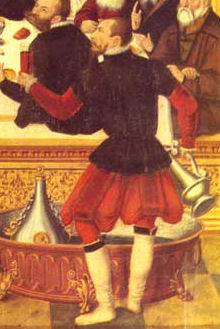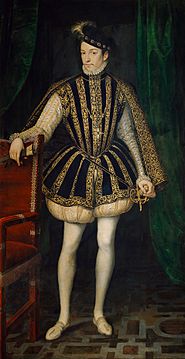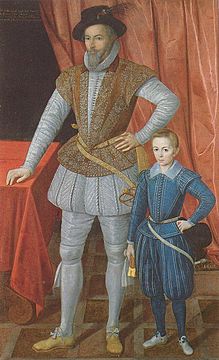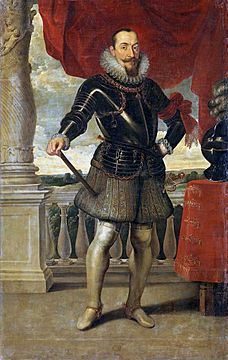Hose (clothing) facts for kids
Hose were a type of clothing worn by men in Europe for their legs and lower body. They were popular from the Middle Ages until the 1600s. After that, people started wearing breeches (like shorts or knickers) and stockings instead. The word 'hose' used to have a plural form, 'hosen'. In Germany, the words Hose (for one) and Hosen (for many) are still used today to mean trousers.
Contents
History of Hose Styles
Early Legwear: Hose in the 1200s
Hose first appeared in Europe around the 1200s. These were like tights that covered the legs from the waist all the way down to the feet. They showed the shape of the legs clearly. Sometimes, a special piece of fabric called a codpiece was added to cover the front. Unlike modern stretchy tights, these early hose were not elastic. They were held up by being laced to a doublet, which was a type of close-fitting jacket. Small holes in the hose allowed them to be tied securely.
Hose in the 1300s: Colors and Comfort
During the 1300s, medieval hose were usually made of wool and designed to fit very tightly. By the end of this century, traders and shopkeepers often wore colorful hose. Some people even skipped wearing shoes. Instead, they wore hose that had leather soles sewn onto the foot part. This meant the hose acted as both legwear and shoes, and the sole was the same color as the rest of the leg covering.
Brighter hose became more common in the late 1300s. They started to look more like trousers, held up by rope-belts around the waist. Sometimes, hose were tied directly to the doublet.
Fashionable Hose in the 1400s
Hose in the 1400s were often particolored or mi-parti. This meant each leg could be a different color, or even one leg could be made of two different colors. These early hose covered the feet, much like modern tights. They had an opening in the crotch area. When very short doublets were in style, codpieces were added to cover this front opening.
Hose Styles in the 1500s and 1600s
By the 1500s, hose had split into two separate clothing items:
- Upper hose or breeches: These covered the upper part of the legs.
- Nether hose or stockings: These covered the lower part of the legs.
From the mid-1500s to the early 1600s, many different styles of hose became popular. These included:
Trunk Hose and Cannions
- Trunk hose (also called round hose) were short, padded hose. Very short trunk hose were worn over cannions. Cannions were fitted hose that ended just above the knee.
Slops and Galligaskins
- Slops or galligaskins were loose hose that reached just below the knee.
Both trunk hose and slops could be paned or pansied. This meant they had strips of fabric (called panes) sewn over a full inner layer or lining. A pansied slop was a round hose with an added layer of panes running from the waistband to the leg band. These were sometimes called "pumpkin" pants because of their puffy look.
Other Hose Varieties
- Pluderhosen were a style from Northern Europe. They were a type of pansied slop with a very full inner layer that puffed out between the panes and hung below the knee. Pluderhosen started in Germany and quickly spread across central and Eastern Europe.
- Venetians were semi-fitted hose that reached just below the knee.
In the later 1500s, breeches started to replace hose. Unlike breeches, which were sewn together as one garment, hose were usually separate pieces for each leg.
Gallery
-
Charles IX of France wearing padded hose, 1566
-
Sir Walter Raleigh in paned trunk hose and cannions, and his son in loose slops, 1602
-
Sigismund III of Poland in Spanish-style hose, c. 1620
See also
 In Spanish: Calzas para niños
In Spanish: Calzas para niños
- 1500–1550 in fashion
- 1550–1600 in fashion






